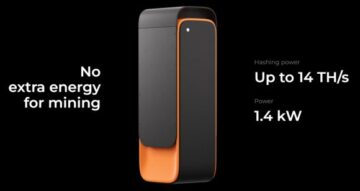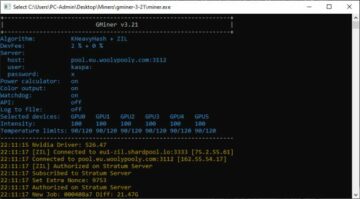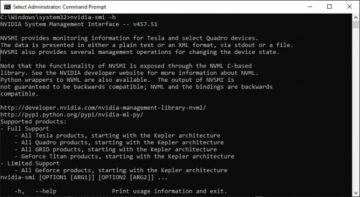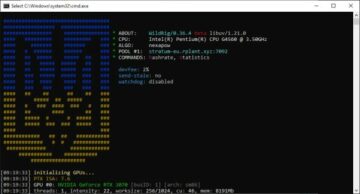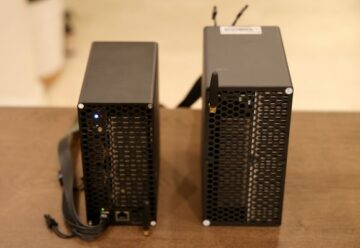5
Nov
2022
We’ve been playing around with a Jasminer X4 1U Ethash and ETChash ASIC miner for a couple of days now and we have some more things to share with you if you are interested in the device. We’ve already covered some interesting findings and possible tweaks for the Jasminer X4 1U ASIC miner here, but we continued further trying to optimize the miner and see if we can squeeze a bit of extra performance from it. Our next obvious step was to disassemble the hashing board with the ASIC chips…
Removing the aluminium cooling heatsink, a single piece for the whole board, revealed the eight Jasminer X4 ASIC chips on the hashing board along with a controller chip and two memory modules. And a ton of thermal grease that needs to be cleaned and replaced before assembling the whole thing back again. Only the controller chip is not covered with thermal grease, instead it uses a thicker thermal pad for contact with the heatsink. All of the chips did have a good contact with the heatsink, so supposedly no expected issues with thermal transfer and cooling here. So, our hopes of getting a bit of thermal improvement by replacing the thermal compound with a better one would probably end in vain, but since we still have to replace the thermal interfacing material we’ll do it.
Cleaning up the whole thing properly does require some time and effort as due to the size of the crystals on the Jasminer X4 ASIC chips it is like cleaning 8 CPUs of computers. And you need to make sure you are careful not damaging anything, though the cleaned-up board and chips do like quite good. We are reusing the original thermal pad for the controller chip as we do not believe it is necessary to replace that one with a more efficient one anyway.
The main controller chip on the hashing board is a Trion T120 FPGA along with two DDR3 memory modules right next to it (no, that is not how 5GB of memory looks like!). This is the controller chip for the Jasminer X4 ASIC chips that is being used on the hashing boards, the miner does have a second FPGA controller chip with separate RAM chips on the main control board that hosts the software and web interface of the miner, there however we find a Xilinx Zinq chip.
Here is a single of the eight Jasminer X4 ASIC chips in a 45×45 mm package (678 square millimetres die size) with 1TB memory bandwidth, 5GB of memory and a hashrate per chip of 65 MH/s with each of the chips having 384 computing cores and 384 on-chip dies according to the manufacturer with a 512-bit bus width, an operating frequency of 800 to 1 GHz and a power consumption of 23 Watts.
We’ve used the Arctic Cooling MX4 thermal compound to cover the chips before reassembling the hashing board with the aluminium heatsink. It is a decently priced high-performance product that we like to use along with Noctua’s NT-H1 due to their great price/performance ratio, and there does not seem to be much point to try and use more expensive solution anyway. When applying other thermal compound make sure to put a little more on the memory chips as there the gap with the heatsink is a bit more compared to the one of the ASIC chips.
We’ve compared the hashrate and operating temperature of the Jasminer X4 1U ASIC miner before changing the thermal compound and after doing so, leaving the device to hash for more than 10 hours in order to get a good average of the operating temp and hashrate. Do note that this is our already silent modified unit with replaced fans and firmware, so your device might report a temperature range and not a single number. The before and after results are very similar, pretty much the same average hashrate and just 1 degree Celsius difference, so there is really no need to play around with the thermal grease as it will not give you much of an improvement. We also did a power usage measurement before and after at the wall, the results there were not much different as well – 266.1 W before and 265.7 W after the thermal grease replacement.
The next thing we wanted to try out here was to use a different power supply than the one the Jasminer X4 1U comes equipped with. There are three obvious reasons to replace the PSU – to see if the 300W of the stock one might be a limiting factor, to use a silent power supply and to possibly get a lower power consumption. We’ve connected a 1000W Corsair HX1000i power supply (Platinum efficiency rating) to the ASIC miner in place of the stock PSU and unfortunately the results were not really that encouraging. You get a silent power supply as the HX1000i runs passively at sub 300W of power usage, but the power consumption measured at the wall was 263.7 W or just 2 Watts less compared to the stock PSU.
The other thing we wanted to check with the more powerful power supply was if the Jasminer X4 1U would be able to run at 250 MHz operating frequency with the new thermal interface material in place and more than enough power. Unfortunately, our miner continued to dislike the 250 MHz operating frequency returning a lot of errors trying to hash and thus effectively operating at a fraction of the actual performance you get at 225 MHz where everything runs stable and without errors. So, the fact that at 250 MHz the mining device uses almost 300 Watts of power measured at the wall does not mean that the stock PSU is not able to handle that. And we do not think that the cooling of the ASIC chips is also an issue here for them not be able to run properly at 250 MHz.
Jasminer X4 does come with a very good thermal grease already applied, so no need to replace it. The stock 300W PSU is also really good in terms of efficiency and is not limiting you running the miner at higher clocks. The only thing is that the stock power supply is quite noisy and you might want to modify or replace it if you are making your miner into a silent one like we did with ours. It seems that Sunlune already did very well with the hardware side of their Jasminer X4 ASIC miners, both in terms of efficiency and performance. What they could work a bit more on however is the software side as their devices do not currently support dual-mining ETH/ETC-based coins along with ZIL, something that could easily bring the miners an extra 30-40% profit. The lack of this feature means that a competitor with dual-mining support already available can easily provide the same profitability with a cheaper device that has lower hashrate and/or is not as power efficient as the Jasminer X4.
- Publihsed in: Mining Hardware|Tests and Reviews
- Related tags: Etchash ASIC, Etchash ASIC miner, Ethash ASIC, Ethash ASIC miner, iPollo, Jasminer, Jasminer modification, Jasminer review, JASMINER X4, Jasminer X4 1U C, Jasminer X4 1U hardware, Jasminer X4 1U hashrate, Jasminer X4 1U mining, Jasminer X4 1U performance, Jasminer X4 1U profitability, Jasminer X4 1U review, Jasminer X4 1U silent modification, Jasminer X4 1U worth it, Jasminer X4 1U-C review, Jasminer X4 1U-C silent modification, Jasminer X4 ASIC, Jasminer X4 ASIC miner, Jasminer X4 hands-on, Jasminer X4 miner, Jasminer X4 review, Jasminer X4 silent, Jasminer X4 silent modification, Jasminer X4 test, JASMINER X4-1U, Sunlune, SUNLUNE ASIC, SUNLUNE X4 ASIC
Check Some More Similar Crypto Related Publications:
- Bitcoin
- blockchain
- blockchain compliance
- blockchain conference
- coinbase
- coingenius
- Consensus
- crypto conference
- crypto mining
- Crypto Mining Blog
- cryptocurrency
- decentralized
- DeFi
- Digital Assets
- Etchash ASIC
- Etchash ASIC miner
- Ethash ASIC
- Ethash ASIC miner
- ethereum
- iPollo
- Jasminer
- Jasminer modification
- Jasminer review
- JASMINER X4
- Jasminer X4 1U C
- Jasminer X4 1U hardware
- Jasminer X4 1U hashrate
- Jasminer X4 1U mining
- Jasminer X4 1U performance
- Jasminer X4 1U profitability
- Jasminer X4 1U review
- Jasminer X4 1U silent modification
- Jasminer X4 1U worth it
- Jasminer X4 1U-C review
- Jasminer X4 1U-C silent modification
- Jasminer X4 ASIC
- Jasminer X4 ASIC miner
- Jasminer X4 hands-on
- Jasminer X4 miner
- Jasminer X4 review
- Jasminer X4 silent
- Jasminer X4 silent modification
- Jasminer X4 test
- JASMINER X4-1U
- machine learning
- Mining Hardware
- non fungible token
- plato
- plato ai
- Plato Data Intelligence
- Platoblockchain
- PlatoData
- platogaming
- Polygon
- proof of stake
- Sunlune
- SUNLUNE ASIC
- SUNLUNE X4 ASIC
- Tests and Reviews
- W3
- zephyrnet









